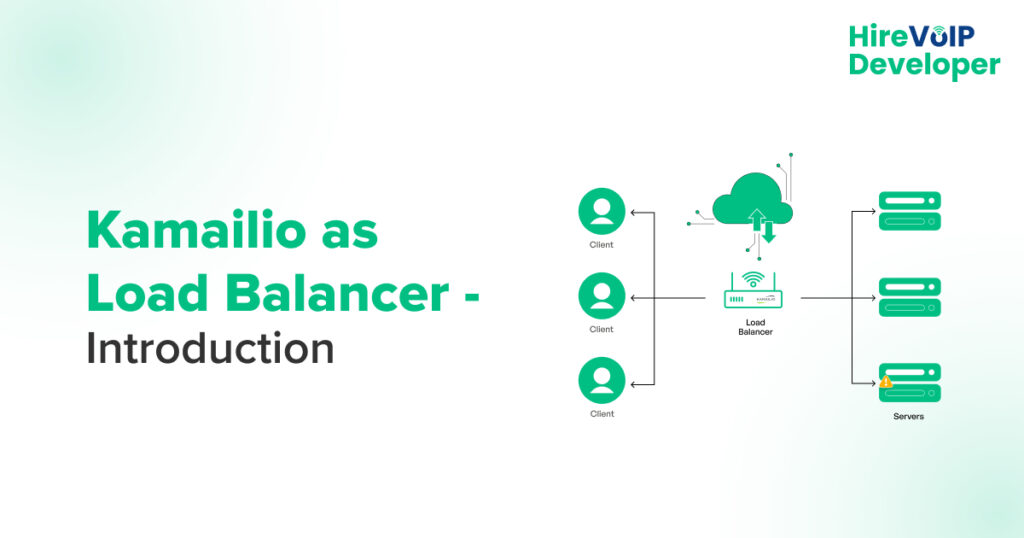📝 Blog Summary
This blog introduces Kamailio as a SIP load balancer, explaining how it distributes traffic using the dispatcher module. It covers key benefits, setup challenges, real-world examples, and future possibilities of Kamailio load balancing.
“A well-balanced system never breaks under pressure;
it reroutes, redirects, and keeps the flow alive.”
In the world of VoIP and SIP communication, traffic management isn’t just a back-end job; it’s a mission-critical need. When calls flood in or traffic surges unexpectedly, how your system handles that load can make or break the user experience.
That’s where load balancing steps in, and more specifically, Kamailio as a load balancer. Kamailio is one of those rare open-source tools that can wear many hats.
And in this blog, we’re going to explore its load balancing capabilities in depth.
🗝️ Key Highlights
- Detailed insight into Kamailio’s role as a SIP load balancer, including how the dispatcher module routes traffic and ensures high availability.
- Clear breakdown of benefits and real-world use cases, like scaling SIP infrastructure and achieving fault tolerance with multiple Kamailio servers.
- Honest look at challenges and future potential, covering setup complexity, maintenance needs, and how Kamailio adapts to evolving VoIP demands.
So, if you’re curious about Kamailio SIP load balancer setups or wondering how to load balance multiple Kamailio servers, you’re in the right place.
What Is a Load Balancer?
A load balancer is like a traffic cop at a busy intersection. It evenly distributes network or application traffic across multiple servers. This ensures no single server is overwhelmed, which keeps the system fast and reliable.
In VoIP, load balancers are vital for maintaining call quality and availability during peak loads.
And What Is Kamailio?
Kamailio is a high-performance, open-source SIP server. It can route SIP messages and handle thousands of concurrent calls.
How Kamailio Can Act as a Load Balancer?
Kamailio isn’t just a SIP server; it’s a powerful SIP load balancer when configured right. Using its dispatcher module, Kamailio can distribute SIP requests to multiple backend servers based on various algorithms.
You can choose to dispatch traffic using round-robin, hashing, or even call load-based methods.
This makes Kamailio ideal when you want to load balance multiple Kamailio servers or even a cluster of FreeSWITCH or Asterisk instances. The dispatcher module reads from a dispatcher list, basically a set of IPs and ports of your backend SIP servers. Each SIP request is then intelligently routed to one of these servers. This creates a seamless call experience for users and reduces the burden on any single node.
And if one server goes down?
Kamailio can detect that and reroute traffic to the remaining active ones.
Did You Know?
Kamailio was once called SER (SIP Express Router); it got a cool new name in 2008. Think of it as a software router that went through a stylish rebrand!
Whether you’re dealing with voice, video, or messaging traffic, the Kamailio dispatcher load balancing strategy keeps the service smooth.
For example, imagine a setup with three media servers. Kamailio can keep tabs on all three, check if they’re alive, and divide traffic evenly.
That’s a classic Kamailio load balancer example, simple in concept but powerful in execution.
Kamailio turns SIP routing into intelligent traffic control with its dispatcher magic.
📞 Want to Streamline SIP Routing with Kamailio Load Balancer?
What Are the Benefits of Using Kamailio as a Load Balancer?
Here’s a detailed explanation of the benefits of using Kamailio as a load balancer:
1. High Scalability
Kamailio is built for high-volume SIP traffic. Whether you’re managing a few hundred or several thousand concurrent calls, Kamailio handles it with ease. You can scale horizontally by adding more backend SIP servers without touching your core logic. This makes it ideal for growing VoIP infrastructures.
2. Flexible Load Distribution
With its dispatcher module, Kamailio supports various load balancing algorithms, round-robin, hash-based, call load-based, or even custom logic. This flexibility lets you tailor traffic distribution based on what suits your setup best. You can also route traffic intelligently based on user group, source IP, or URI pattern.
3. Built-In Failover and Redundancy
One of Kamailio’s strongest features is its ability to detect server failures and reroute traffic to healthy nodes. This means if a backend SIP server crashes, Kamailio automatically removes it from the rotation, ensuring calls stay connected and the user experience isn’t interrupted.
4. Cost-Effective and Open-Source
Unlike commercial SIP load balancers, Kamailio is open-source and free to use. It doesn’t demand expensive licenses or specialized hardware. With low memory and CPU usage, it can run on modest infrastructure, saving money while delivering enterprise-level performance.
Did You Know?
Load balancers don’t just balance, they can heal! If a server goes down, the load balancer reroutes traffic like nothing ever happened. Smooth operator!
5. Advanced SIP Routing and Customization
Kamailio is more than a load balancer; it’s a full-featured SIP proxy. This allows you to implement advanced routing logic, enforce SIP policies, apply filters, and even integrate authentication mechanisms. You can inspect, modify, or route SIP messages in real time, making it a versatile solution.
6. Protocol and Platform Agnostic
Kamailio supports UDP, TCP, TLS, and WebSocket transports, making it a fit for a wide variety of clients and SIP servers. Whether you’re using Asterisk, FreeSWITCH, or OpenSIPS as your media servers, Kamailio can sit in front and manage the traffic effortlessly.
7. Active Community and Continuous Updates
Being open-source doesn’t mean being outdated. Kamailio has an active developer and user community. Frequent updates, detailed documentation, and a wide support network mean you’re never alone when deploying or troubleshooting your setup.
8. Improved Security and Network Isolation
Kamailio acts as a buffer between external clients and internal SIP servers. This not only distributes the load but also adds a layer of security. You can configure it to detect malformed SIP packets, block suspicious traffic, and prevent SIP flooding or DoS attacks.
Together, these benefits make Kamailio load balancer a reliable, flexible, and cost-effective solution for VoIP infrastructures of all sizes. Whether you’re setting up your first VoIP cluster or optimizing an existing system, Kamailio is a strategic asset in your SIP traffic management stack.
Did You Know?
First come, first served? Not always!
Some load balancers use algorithms so complex, they make chess engines look basic. Round-robin is just the beginning.
What Are the Challenges and Its Future Scope?
Of course, it’s not all smooth sailing.
While Kamailio SIP server is a powerful tool for SIP load balancing, it does come with its own set of challenges, especially for those new to SIP infrastructure or open-source telephony systems.
1. Complex Configuration
Kamailio’s flexibility is both its strength and a hurdle. Unlike plug-and-play load balancers, Kamailio requires in-depth SIP knowledge to configure correctly. Setting up the dispatcher module, writing routing logic in its scripting language (KEMI or native), and managing SIP headers all require expertise. Even a small misconfiguration can lead to failed call routing or unintended behaviour.
2. Steep Learning Curve
The Kamailio scripting language and modular design can be intimidating. New users often struggle with understanding how different modules interact, how SIP message flows should be handled, and what parameters need to be adjusted. Even experienced engineers may need time to experiment and fine-tune setups, especially in large or distributed environments.
3. Lack of Built-in GUI
Out of the box, Kamailio does not offer a graphical interface for managing or monitoring dispatcher lists or traffic statistics. This makes real-time troubleshooting and analytics difficult unless third-party tools like Siremis or custom dashboards are integrated. Without proper logging and monitoring, diagnosing issues like uneven load distribution or failed failovers becomes time-consuming.
4. Ongoing Maintenance
As your network grows, you’ll need to continuously update the dispatcher list with new backend servers or remove inactive ones. While Kamailio supports database-driven dispatcher lists for dynamic updates, setting up database connectivity and syncing data correctly adds an extra layer of complexity. Plus, software and module updates must be handled with care to avoid breaking live traffic.
5. Limited Built-in Health Checks
Although Kamailio supports basic health checking (using OPTIONS pings), it lacks the comprehensive health-checking mechanisms found in modern load balancers like HAProxy or Nginx. You may need to develop external scripts or integrate with monitoring systems to ensure robust health and failover handling.
6. Scalability Planning
While Kamailio itself is scalable, ensuring your overall system scales smoothly involves additional planning. Load balancing decisions need to consider SIP NAT traversal, transport protocols (UDP, TCP, TLS), and media server capacities. Load balancing too many services or protocols without detailed planning can overwhelm Kamailio’s SIP routing logic.
Did You Know?
Kamailio can handle over 100,000 calls per second on modest hardware. Yes, it’s basically the superhero of SIP routing, minus the cape, but with killer performance!
In short, while Kamailio is a highly efficient and flexible SIP load balancer, getting it right involves a good grasp of VoIP technologies, careful configuration, and proactive maintenance. It’s ideal for teams who are ready to invest the time and expertise required, or who have expert partners to help them navigate the setup and scaling journey.
🧩 Unlock the Full Potential of Kamailio Load Balancing
Wrapping Up
Kamailio doesn’t just handle SIP, it orchestrates it with precision.
When used as a SIP load balancer, it ensures traffic is evenly distributed, services stay available, and calls don’t drop. The Kamailio dispatcher load balancing mechanism gives you control while keeping things lightweight and efficient. From startups to telecom giants, teams rely on Kamailio load balancing to scale without hiccups.
Benefits of Using Kamailio as a Load Balancer
- High Availability: Automatic failover protects against downtime.
- Cost Efficiency: Open-source and resource-friendly.
- Flexible Routing: Supports complex routing logic for SIP traffic.
How Hire VoIP Developer Can Help?
If configuring Kamailio feels overwhelming, that’s where Hire VoIP steps in.
Hire VoIP Developer provides expert guidance, deployment support, and customized setups for businesses of all sizes. Whether you need a Kamailio load balancing solution or want to optimize your existing setup, our team can help you build a future-ready VoIP system.


